
Communication, as discussed in the role and power of mass media is a complex and dynamic process leading to the evolution of meaning. Systematic study of mass communication and mass media over the years has led to the formulation of several theories.
These theories are broadly categorized as Structural and Functional Theories, cognitive and Behavioural theories, Interactive theories, Interpretive Theories and Informative Theories.
The Structural and Functional Theories perceive the social structures as real and as functions in ways that can be seen and observed objectively.
The Cognitive and Behavioural Theories are focused on the psychology of individuals, while the Interactionist Theories view social life as a process of interaction
The Interpretive Theories reveal the way people understand their own experiences, while the Critical Theories are concerned with the conflict of interests in society and the way communication perpetuates domination of one group over another.
At the end of this post, you should be able to;
- Enumerate the basic theories of Mass Communication
- Discuss the challenges of the various theories in a fast-changing world
- Lastly, explain the relevance of the mass communication theories to various societies and societal situations.

The Classical (Normative) Theories of Mass Communication
The Classical Theories of Mass Communication are:
- The Authoritarian Theory,
- The Libertarian or Free Press Theory,
- The Social Responsibility Theory, and
- The Soviet Media/Communist Press Theory.
Each of these theories are based on a particular political system or economic scenario. According to McQuail, theories simply express ideas of how the media ought to operate, or can be expected to operate, under a set of conditions or values. hence he called them Normative Theories.
1. THE AUTHORITARIAN THEORY
Here, the state exercises direct control over state-owned media while other media not owned by the state must follow the bidding of the state or, succinctly put, must dance to the tune’ played by the state.
The Authoritarian Theory has its origins in the authoritarian philosophy of Plato (407-327BCE). According to Plato, the state was only safe in the hands of a few wise men. This concurred with the work of British academician Thomas Hobbes (1588-1679) who argued that the power of maintaining order was sovereign, and that individual objects were to be ignored.
This was reinforced by Friedrich Engels, a German thinker (1820-1895), who claimed that freedom came into its supreme level only under authoritarianism.
It does seem that both dictatorial and democratic governments all over the world usually devise means to gag or control the media.
The works of Hobbes and Engels perhaps influenced the authoritarian approach in early Western Europe wherein freedom of thought was jealousy guarded by only a few people (that is, the ruling class) who were primarily concerned with the emergence of a new middle class and were worried about the effects of printed
matter on their thought process.
To checkmate these, steps were taken to control freedom of expression. This resulted in the advocacy of complete dictatorship. This theory promoted zealous obedience to a hierarchical superior and reliance on
threat and punishment to those who did not respect authority.
Press censorship was justified on the grounds that the state always took precedence over the individual’s right to freedom of expression.
THE LIBERTARIAN OR FREE PRESS THEORY
This theory has its roots in the 17th Century England when the printing press made it to produce several copies of a book or pamphlet at cheap rates. This theory advocates the complete removal of restraints, with emphasis on individual freedom. It perceives the state as a major source of interference with the of an individual and his or her property.
To the Libertarian, taxation is institutional theft. The theory assumes that popular will should prevail over the power of the state.
Key proponents of this theory were Lao Tzu and John Locke. Other advocates were John Milton (1608-1674) and John Stuart Mill (1806-1873). Milton in Aeropagitica 1644), referred to it as a self-righting process if free expression is permitted. “Let truth and falsehood grapple,” he declared.
In 1789, the French Declaration of the of the Rights of Man posited that “Every citizen may speak, write and publish freely.” This doctrine gave birth to the idea of a “free marketplace of ideas.”
According to the Libertarians, the press should be seen as the “Fourth Estate”, reflecting public opinion, to wit, power without social responsibility. This is summed up in George Orwell’s (1903-1950) definition of Libertarianism as “allowing people to say things you do not want to hear.”
3. THE SOCIAL RESPONSIBILITY THEORY
The Social Responsibility Theory was propounded by the critics of a free press, Wilbur Schramm, Siebert and Theodore Paterson.
According to them, pure Libertarianism is antiquated, outdated and obsolete. The Social Responsibility Theory, which they claim should replace the Free Press Theory, has its origin in the United States of America. It was based on the observation made by the Commission of The Freedom of Press (1949) in which it was asserted that the free market approach to press freedom had only increased the Power of a single class and had not served the interests of the less well-off classes.
Some means of accountability become imperative, particularly with the emergence of radio, TV and film. The thinking here is that the media organizations should owe some obligation to the society with such imperatives as self regulation, state regulation and high professional standards.
This makes the Social Responsibility Theory a modern variant in which the duty to one’s conscience is the primary basis of the right of free expression.
4. THE SOVIET MEDIA/COMMUNIST PRESS THEORY
This theory was based on the ideologies of Engels and Karl Marx (1818-1883) which perceived the ideas of the ruling classes as the ruling ideas. They perceived the entire mass media as being saturated with middle-class ideology or ideas supporting the traditional values of members of the middle class who were primarily interested in social status.
Vladimir Lenin (1870-1924) in his contribution held that private ownership was
incompatible with freedom of the press and that modern technological means of information must be controlled.
According to this theory, the sole purpose of the mass media is to educate the great masses of workers and not to give out information. The public was encouraged togive feedback, as it was the only way the media would be able to cater for its interests.
THE NON-BASIC OR NON-CLASSICAL THEORIES OF MASS COMMUNICATION
The Non-Classical Theories were more applicable to the Non-aligned Countries of a and Latin America which were committed to social and economic development on their own terms.
The theories are:
- The Development Communication/Media Theory,
- The Democratic Participant Media Theory, and
- The Agenda Setting Theory.
1 THE DEVELOPMENT COMMUNICATION/MEDIA THEORY
This theory is premised on the belief that there can be no development without communication. While the Development Support Communication Theory (as this theory is otherwise called) enables the media to undertake the role of carrying out positive developmental programmes, voluntarily accepting restrictions and instructions from the state, the media subordinate themselves to political, economic, social and cultural needs under this school of thought.
The theory has the tacit support of the United Nations Educational, Scientific and Cultural Organisation (UNESCO). The major drawback of the theory is that development is often equated with government propaganda, especially in the countries generally classified as “developing”.
2. THE DEMOCRATIC PARTICIPANT MEDIA THEORY
This theory is sternly opposed to bureaucratic control of the media. It stresses the for access and the right to communicate. It is strongly opposed to the commercialization of modern media and their top-down non-participant character.
3. THE AGENDA SETTING THEORY
This theory highlights the ability of the media to influence the significance of events in the minds of members of the public. In this scenario, agenda for discussion are set by the media, which also mentally order and organize their world. The theory concurs with the “Use and Certification” approach.
According to McCombs and Shaw, the agenda-setting function of the media causes the correlation between the media and public ordering of priorities. The media agenda affect largely those who have a high need for orientation.
In conclusion, both the Classical and Non-classical Theories of the media, as discussed in this module,
have direct and tacit political, economic and cultural impact on society.
Based on the above, you could be faced with questions like;
- Mention three (3) Non-basic Theories of Mass Communication and discuss one of them with specific reference to the relevance of the theory to the Nigerian society.
Compare and contrast the Libertarian (Free Press) Theory with the Social Responsibility Theory.
Discuss the possible challenges posed to the Authoritarian Theory of Mass
Communication in the present global dispensation of freedom and openness.
You should be able to comfortably attempt the above questions if you read and digest properly, all the theories of mass communication as explained above.
You could send us your opinion as regards the Mass communication theories in other to make this article more interactive as other readers would gain a great deal, loads of information from your inputs.




